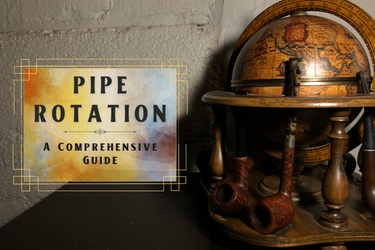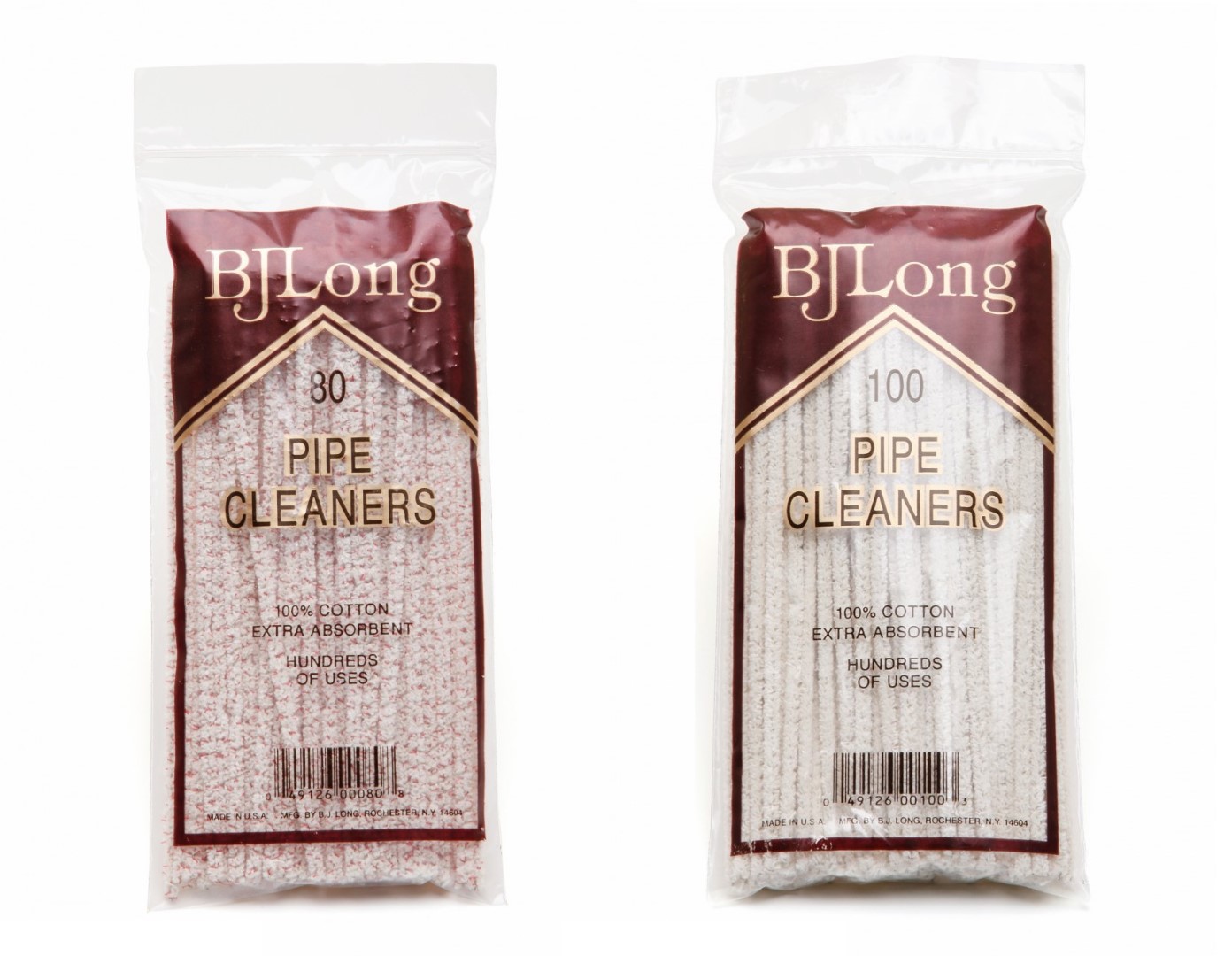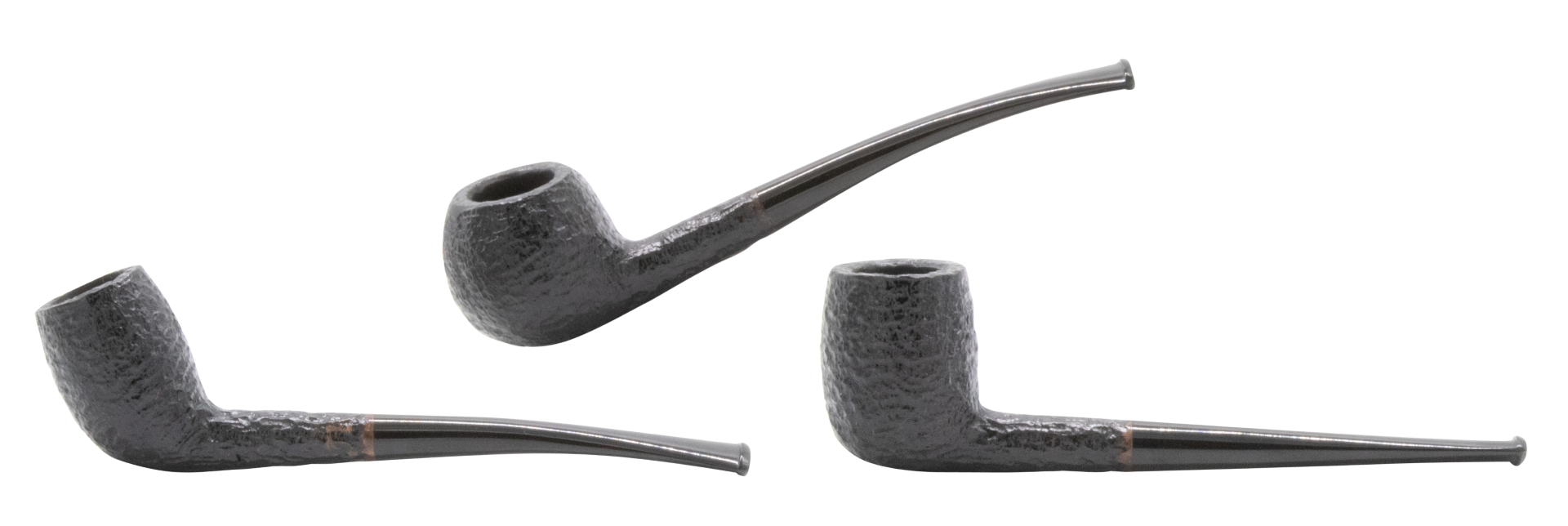Pipe Rotation: A Comprehensive Guide
Posted by Greg Rosenberg on 10th Feb 2023
Table of Contents
- What is a pipe rotation
- Why do tobacco pipes need rest
- How long should a pipe rest between smokes
- Building a pipe rotation
- Quality and affordable briar pipes
- Dedicating pipes
Establishing a pipe rotation can be a confusing subject for newcomers to tobacco pipes, but it need not be. Like many aspects of the hobby, it’s a loosely defined practice that accommodates a personal approach—if one chooses to integrate the practice at all.
At its simplest, building a pipe rotation is another way we provide for the contingencies of our pipes’ health and the agreeability of each smoking experience. Some pipe smokers develop a meticulous system for these ends—others, a casual mindfulness. Here, I want to get into the reasons for and approaches toward a pipe rotation. With that knowledge, we can let preference and individuality take the reins.
What is a pipe rotation?
Common pipe smoking wisdom tells us that a smoked pipe should have time to rest. Essentially, pipe rotating is the practice of facilitating that rest without abstaining from enjoying a smoke when the desire arises by building up a collection of pipes, sometimes (but not necessarily) fixed to a regiment of use.
This usually means resting a pipe after each smoke, but for some, the idea of pipe rotating may mean that one pipe is dedicatedly packed and puffed throughout a day, to be benched and rested until its day comes again.
Though some may opt for a more established routine—such as having a pipe for each weekday, i.e., a 7 day set—many will practice pipe rotating casually. When you have a decent collection assembled, spacing out the smoking of a given pipe doesn’t take much organizing. But it can be a bit daunting for those starting out. For the beginner pipe smoker, it can seem that enjoying a smoke with some level of regularity means having to spend quite a bit on several pipes out of the gate. We’ll get into some budget friendly approaches, but first, let’s discuss why many favor resting a pipe.
Why do tobacco pipes need to rest?
Well, it’s actually wooden pipes that we are mostly concerned with here—most often briar pipes. The reason is the heat and moisture that results from smoking.
Damage to a pipe from overheating
The combustion from smoking heats the bowl, and not allowing time for the pipe to cool after smoking can cause damage to the shank, or a burn out in the bowl. This sounds scary, but I don’t want to lead you astray with horror stories—this is rare. If it’s a well crafted pipe that is cared for and isn’t disassembled while still hot, it’s very unlikely the shank will crack.
As for burnouts, they are very uncommon, but when they do occur, there’s often an underlying, unforeseen flaw in the briar. If that’s the case, the burnout is likely to develop within the first few smokes (identifiable by a localized section of char/webbing on the chamber wall), and the matter should be remedied by the manufacturer or retailer. Short of such outlying circumstances, if a pipe has been thoughtfully broken in and is well cared for (maintaining a thin cake and avoiding smoking too hot) you should have nothing to worry about.
Rotating pipes to get the most out of a smoking experience
Then there’s the quality of the smoking experience itself. Of course, this is quite subjective and there are pipe smokers who will attest to fine smokes one after another, day after day, in one pipe. But no doubt many pipe smokers have experienced acrid, harsh, and/or dull smokes from such a routine. I highly recommend G. L. Pease’s article Give it a Rest in which he relays his experiment of smoking in this manner.

Built up moisture can cause gurgling and a sour taste when smoking. Regardless of whether we plan to pack that pipe again in seven minutes, seven hours, or seven days, we should be running a pipe cleaner after each smoke to remove excess moisture and gunk. I'll even wipe down the chamber wall with paper towel or a looped pipe cleaner, such as the one pictured above.
But even after doing this, the inner bowl feels slightly damp. I can only imagine the same is true for the rest of the internals. To once again get a really dry smoke, you just need time.
How long should a pipe rest between smokes?
24 hours. Scientifically, objectively, twenty-four hours.
Just kidding. If you’ve been a pipe smoker for five minutes you probably know nothing’s that straight forward. That said, one day is a pretty common answer to the question, and it seems like a fine place to start. I would say add a day or two if you have a few pipes to rotate, but ultimately, you’ll just let your experience be the guide from there.
There are no hard and fast rules as to the perfect time to leave your pipe at ease. Since moisture and heat are major factors, the tobacco and the pipe in question matter greatly, as does how you smoke (packing, cadence, lighting—all that business). Some tobaccos are more moist. And since the combustion allows the moisture to get into the heel of the chamber and into the airway, naturally the physics of that pipe will have their say.
And then there’s simply the palate of the beholder. If you smoke in quick succession and get a spoiled, sour blitz to the tongue, you don’t have to be the god or goddess of delicate nuance to say, “hey, that wasn’t very fun.” Then again, if you’re losing some of the subtleties of the flavor profile, you’re probably not going to feel like your grand smoking experience was harshly undercut, especially if you’re still developing a palate that recognizes such nuance.
Which is all to say, just experiment and see what works for you. But there are some factors regarding wait time we can control—a little proactivity can do you well in the long run.
Mitigating rest time
So, what can you do to be proactive against a sour pipe? Even if you don’t put any stock in a pipe rotation or resting time, the following is just good form in general. In fact, it’s all the more necessary if you aren’t going to be resting a pipe.
First off, keep that pipe clean. Run a pipe cleaner after each smoke. The sooner the better, before letting that moisture soak in and before that gunk gets more set. You’ll notice how much more dirty a cleaner is after being run through a pipe that was just smoked versus some time after the smoke, even if it hadn’t been touched since. I will usually use two pipe cleaners after a smoke; first bristled, then fluffy.
You may even want to give your pipe a run or two with a cleaner mid-smoke, especially if it’s a particularly wet tobacco.

But remember, if the pipe doesn’t pass a cleaner, i.e., you can't get one all the way through from the bit to the heel without taking the pipe apart, just get out as much as you can without any disassembly, and then separate it and run the cleaner through once it’s cooled off. Also, wipe around the base of the tenon and the sides of the mortise when they are separate, as moisture and gunk easily collect here (see illustration below). But again, wait for a while after you’ve smoked. Removing the stem before the briar has time to cool can result in a cracked shank. In fact, wait till it’s cool then wait some more.

Red areas show the easily overlooked spaces buildup can occur
In addition to that per-smoke cleaning, periodically give the pipe a deep clean. Use a pipe cleaning solution such as BriarVille Pipe Cleaner and Sweetener with pipe cleaners and brushes to really get that residue out. Neerup offers a great assortment of brushes shaped to clean the chamber, mortise, and draft hole.

Also keep the cake nice and trim. The carbon cake in the chamber is great for insulating the briar, but it holds moisture. You may need to ream the pipe from time to time, although I recommend the aforementioned practice of wiping the chamber walls with a paper towel or twisted up cleaner after smokes, this way cake develops very slowly and evenly and there is only very occasionally any need for removing cake (though, you might want to wait until a new pipe has some cake before this becomes routine).
And if you do ream your pipe, know what you’re doing. It’s not as daunting as it’s sometimes made out to be, but the results can be devastating if not approached with some background knowledge. Remember, the more you keep on top of regular upkeep, the less demanding the occasional deep clean. There’s a big difference between trimming cake and heavy reaming.
Building a pipe rotation
How many pipes do you need for a rotation? That depends on how often you smoke, what you’re smoking, if you’re dedicating pipes (we’ll get into that), and other factors. Again, it’s just one of those things you’ll feel out. Let’s get into how you might approach putting a pipe rotation together.
Get a few corn cob pipes
There are a lot of reasons beyond affordability to have some cobs on hand, but that price point certainly helps when building a pipe rotation. In addition to having some other backups while that briar rests, you also might want some “activity” or “knock around” pipes. Sometimes we like having a smoke while taking care of the yard work or are otherwise active and don’t want to risk damaging one of our nice briars, especially if you only have one or two.

In fact, my personal approach to pipe rotating is of the casual variety. I have enough pipes I enjoy that there’s always an option while recently used pipes are given a few days rest. The exception however, is a self-assembled seven day set of corn cob pipes. I go to the dog park to play fetch with my boy Bishop just about every day. I much prefer having a trusty, cheap cob for this. And right by my door I keep an old spoon wall-mount that conveniently holds seven cobs, one for each day of the week. Those are my fetchin’ cobs.
Consider a meerschaum pipe
Cobs are so affordable, it’s easy to get several for very cheap, but they’re also best served by having some time to dry out. However, meerschaum pipes don’t require such a rest time. Though they may not be inexpensive, one can go a long way. You can turn to that meerschaum and smoke it, smoke it, and smoke it again while the briar rests.
They’re also just gorgeous and wonderful smokers in their own right. Altinay and Rattray’s both have some great options for meerschaum pipes that aren’t too pricey.

Keep in mind, while you don’t need to rest a meerschaum pipe like a briar, the same rules apply with maintenance. Keep that smoker clean, and keep running those pipe cleaners. It’s especially a good idea to wipe down the bowl after each use, as you don’t need a layer of cake in a meerschaum pipe, and having one that builds up too much can be detrimental.
Quality and affordable briar pipes
If you are looking for some briar pipes to start filling out that rotation, here are some recommendations for inexpensive yet fine pipes. I’ll list some series that I think are great options, but I encourage you to look into the brands for a pipe that really speaks to your tastes.
And keep in mind, we regularly do brand-wide sales on our pipes. Subscribe to our email at the bottom of the Tobaccopipes.com home page or keep up with us on socials (facebook, instagram) and there’ll certainly be some opportunities for deals.
Morgan Bones
Savinelli Arcobaleno
Peterson Aran
Rossi Piccolo
Molina Tromba
Lorenzetti Avitus
Nording Compass
Dedicating pipes
Dedicating pipes is another practice you’ll hear about and it’s somewhat at odds with rotating pipes when you’re starting out. In general, I suggest beginners don't worry too much about dedicating, but you should understand what it is so you can decide if it’s something to consider now.
Basically, dedicating is the practice of having certain pipes exclusively used for certain blend types (or even certain blends). Especially blend types that are more prone to ghosting a pipe. This refers to when a blend leaves behind flavor in a pipe and affects later smokes. This is mostly a concern with more potent varietals like Latakia or Perique, or generously flavored Aromatics.
If you do want to dedicate, keeping a few cobs exclusively for those sorts of blends is a good place to start while you build up your briar collection—meerschaum is also handy here as they’re less prone to ghosting. But again, if this seems like one more factor complicating things, don’t fret about it. Many seasoned pipe smokers don’t dedicate—you’ll figure out what works for you.
Like all things in pipes and tobacco, it's about finding your own rhythm. No one can prescribe the right approach because that's to be determined by our own developing preferences. But what I've tried to offer here is some of what works for others and (in some but not all cases) myself. Hopefully that provides some jumping off points to start uncovering what works for you.









